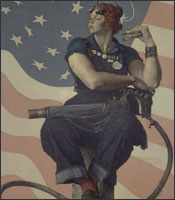
Norman Rockwell (1894-1978) found Arcadia on Main Street, creating a small-town paradise close to the American heart. He is our mom-and-apple-pie man, the Jimmy Stewart of artists. His covers for the Saturday Evening Post, sweetened with corny humor, are invariably sentimental and reassuring. Nothing is wrong in a world where the country doctor earnestly listens to the heart of a little girl’s doll, Rosie the Riveter has a lace handkerchief, and high-school sweethearts go to the soda fountain after the prom. His icons of American innocence still reduce many people to happy sniffles and aw-shucks smiles. It’s enough to make others want to kick a puppy.
During his life, the art world condescended to Rockwell, assigning him the status of a “great illustrator” rather than the loftier position of an “artist.” He became a proxy in the cultural wars over modernism, with those who hated abstract art championing him and those who defended abstract art turning up their noses in the presence of his work. Now, with those wars long past, both the puppy kickers and the apple-pie lovers are being trumped by the art historians – who want to give Rockwell a higher position in the pantheon of American art. Norman Rockwell: Pictures for the American People, an exhibition of 70 oil paintings and 322 Post covers that recently opened at the Solomon R. Guggenheim Museum, reflects this revisionist view of Rockwell’s place in the canon.
It’s remarkable that the Guggenheim should even exhibit Rockwell. The museum began as an edgy institution that asserted the value of European art – especially abstract and surrealist art – to a doubting and provincial public. That this big-city institution should now honor a small-town American realist is a measure of how much the world has changed. What’s led art historians to reconsider Rockwell is even more interesting. One important factor is that many of today’s art historians are less interested in art than in history, especially social history. Rockwell can easily be presented as a brilliant social conjurer, one who serves his society’s desire to conceal unpleasant social realities behind an aura of nostalgia and virtue; his famous “Four Freedoms” helped buck up the nation during World War II, for example, by creating simple-minded depictions of what soldiers abroad were defending. Another important factor is, simply, the desire of many art historians to celebrate pop kitsch and disturb the highfalutin view. There is not much left that can shock – sex and violence are played out – so why not surprise everyone by celebrating the straightest man in the world? Rockwell is more controversial than Betsy Ross in drag.
But the main reason for this Rockwell resurgence is the current uncertainty about how to value art – and the cultural unwillingness to make distinctions of quality. Rockwell is a great American original, but he is far from being a great artist. His pictures imprint themselves upon the mind, but they do not deepen the imagination. Once their intent is grasped, they do not continue to unfold or reveal themselves. They were painted to be reproduced and, while displaying excellent craft, lack the formal texture of great painting. Everything Rockwell does becomes corny and childlike. With the exception of one picture of killings in the South, even his paintings about civil rights take away any sting, resolving that great subject into a heartwarming shot of a jaunty little girl who will obviously transcend adult violence and prejudice. The trouble with overvaluing Rockwell is that doing so diminishes our sense of what high achievement consists of. The great American imaginations, even the folksy ones, are knottier than Rockwell. (Imagine Mark Twain without his edges.) Rockwell himself did not seem to overvalue his achievement. He would surely have taken comic delight in seeing his pictures in the sublime spiral of the Guggenheim, and, perhaps, he would have dreamed of a girl with freckles and pigtails roller-skating down the ramp. But Frank Lloyd Wright would not have been amused.
Norman Rockwell: Pictures for the American People
At the Solomon R. Guggenheim Museum; through 3/3/02.